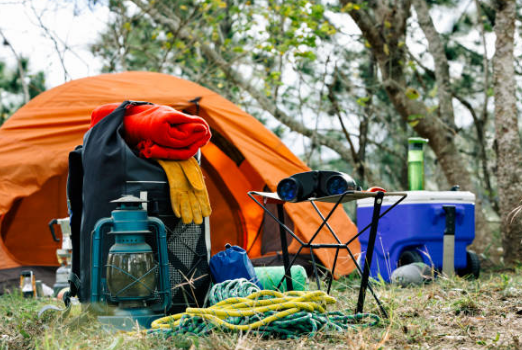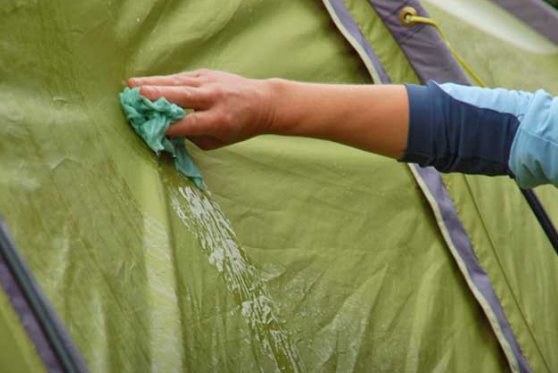One of the main functions of a tent is to protect it from rain, so it may seem like a strange thing for a tent to be waterproof. But even the best quality camping tents can degrade over time and lose their effectiveness against the elements. So, when it’s time to decorate your wilderness home a little, you need to know what to do and how to waterproof your tent.
Why Tents Need to Be Waterproof
While most decent tents are waterproof at the time of purchase, there are some low-end tents on the market that only claim to be waterproof. These tents are not waterproof at all and will begin to melt at the slightest hint of moisture in the air. Well, not exactly. But when the wind and rain go down, they certainly don’t provide enough protection. Adding waterproofing to such a tent does not make it waterproof, but it can improve its waterproofness.

Sun Damage
Just as harmful UV rays can damage our skin, it can cause irreversible damage to fabrics that are exposed to the sun for long periods of time. Even camping in the summer sun for a few weeks can cause serious damage to the tent’s flysheet, reducing its effectiveness against heavy rainfall. One of the best ways to extend the life of your tent is to protect it from sun damage. If you regularly camp in the sun, read on to find out how to do it.
Use and Age
The fabric is often subjected to wind and rain, covered in mud and dust, dried in the sun, and then crumpled into a ball and placed in a bag for several months, where it gradually deteriorates over time. Weather and dirt can cause moisture to be absorbed by the fabric, making it less effective against rain and wind. Applying a tent waterproofing treatment can help extend the life of the tent fabric by adding a DWR coating to the surface of the fabric. This causes water droplets to run down the fabric, preventing water from accumulating in one space and penetrating the fabric.
Damaged Seams
Time and outdoor use can also affect the strength of the tent joints. Most tents come with fully sealed seams when they are first purchased. But seals can break over time, causing water leaks at the seams. Adding seam sealant can solve this problem.
Identify the Problem
Before covering the entire tent and all its seams with expensive waterproofing material, it’s a good idea to figure out which part of the tent isn’t working properly. Assess your tent for the next rainstorm, or set it up in your backyard, douse it with water, and look at the following:
How to Make a Tent Waterproof
Some people regularly waterproof their tents after every few times they use them. While others may only do it once for the life of their tent! How often your tent is waterproofed depends on how often you use your tent, how well you take care of it, and the conditions in which your tent will be used. We recommend doing it at least once a year, at the beginning of the camping season.
Clean the Tent
- You’ll need to thoroughly clean your tent before applying waterproofing treatment, seam sealant, or repair tape.
- Set up your tent
- Fill a bucket with warm water and add some mild detergent or technical cleaner
- Gently wipe with a sponge until clean, paying special attention to the seams
- Waterproofing the tent before drying the tent
Carry out Tent Waterproofing
- Set up your tent
- Make sure the tent is clean and moist
- Use a sprayer, brush or sponge to apply the agent to all parts of the tent
- Wipe off excess product with a damp cloth
- Allow it to dry completely before putting it away

Seal the Seams
- Make sure the tent is clean and dry
- Place your tent in a clean, flat place with the seams facing up
- Use a dry rag and wipe the seams with a small amount of rubbing alcohol to clean the fabric
- Carefully remove any flaking parts
- Follow the instructions to apply the seam sealant with a small brush
- Allow it to dry completely before putting it away
The Best Waterproof Tent Spray
There are a number of different tent waterproofing treatments available. Some combine tent cleaning with waterproofing. Other methods add UV protection. Here are some of the best options:
Nikwax Tent and Gear Solarproof
One of the best ways to waterproof a tent is actually preventative. This sunscreen treatment not only increases water resistance, but also strengthens the fabric and prevents UV damage. This should be done before the tent is used.
Kiwi Camp Dry Heavy Duty Water Repellent
Unlike Nikwax products, this Kiwi Camp treatment contains a lot of chemicals. Two coats are required to achieve the best results, and can also be used for items other than tents.
Nikwax Tech Wash
Although Nikwax Tech Wash is primarily a washing treatment of technical fabrics, it also restores breathability and water resistance. As a precautionary measure, adding some water repellent is a good option.
Star Brite Waterproofing Spray, Stain Repellent + UV Protection
This product is used in the same way as Nikwax Solarwash to protect your tent before use. However, it should be applied while the tent is dry, and can also be used on other items.
Scotchgard Outdoor Water Shield
This is a simple, single-use, waterproof tent spray that can also be used to add waterproof performance to other outdoor gear.
Canvas Waterproofing
Some of the most luxurious and durable camping and glamping tents are made from cotton canvas – bell tents or teepees perform very well in inclement weather. This high performance is due both to the structural design and to the robustness of the canvas fabric. Cotton canvas relies on the natural properties of the fibers to create a highly weatherproof fabric that has been used by campers for centuries.
However, when it comes to canvas tents, it’s important to note that during the first few rains, you may find that they leak. This is not because they are flawed, but because once the cotton canvas gets wet, the water resistance actually improves. Once wet, the cotton structure of the fabric tightens, effectively sealing all the small holes in the rough fabric. So, before you spend a fortune on an expensive and time-consuming canvas waterproofing, try getting your tent wet!
Tent Waterproofing with a Tarp
If you don’t want to chemically treat your tent, or if it’s too late for you to waterproof your tent on your upcoming trip, you can always add tarpaulins to your camping gear!
Set up the tent as you normally would, then put a tarp over the tent and make sure the entire tent is covered. Consider where the water on the tarp will go and make sure there is no gear or shoes in this area, etc.
Tent waterproofing may seem like a chore, but it can extend the life of a tent for many years. It’s worth doing, and your efforts will save you some valuable money and prevent another undesirable item from being discarded in landfills.

